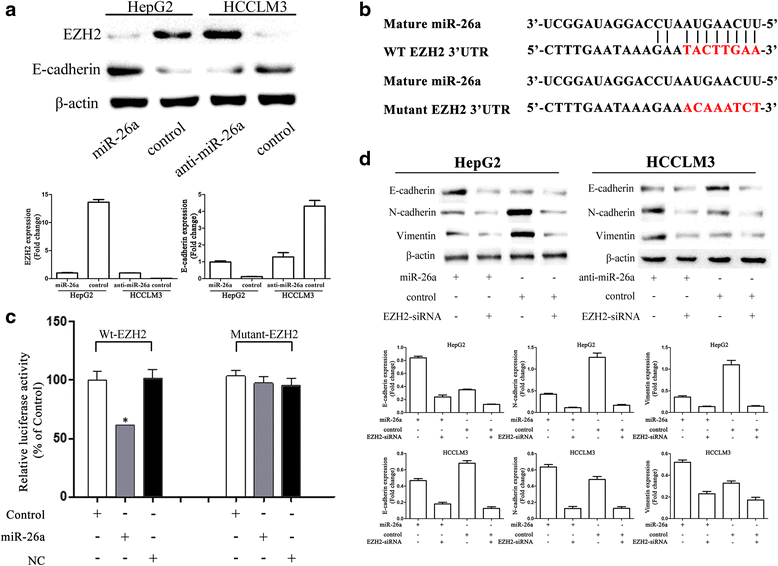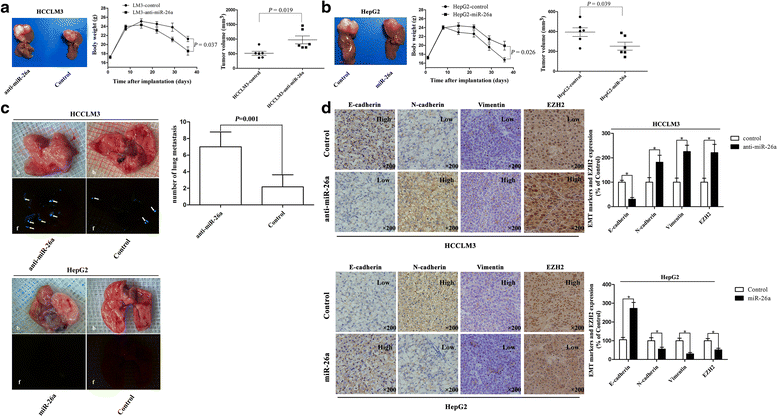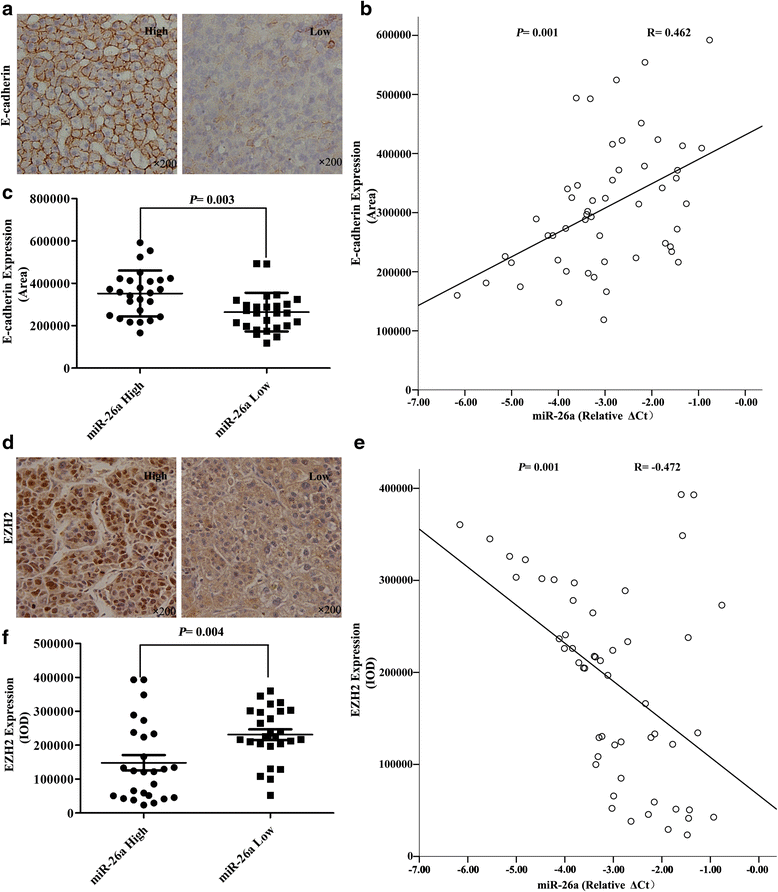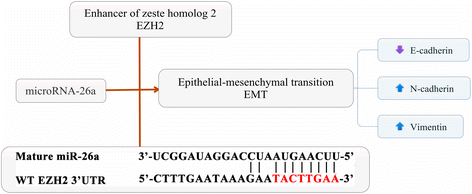MicroRNA-26a suppresses epithelial-mesenchymal transition in human hepatocellular carcinoma by repressing enhancer of zeste homolog 2
- PMID: 26733151
- PMCID: PMC4702409
- DOI: 10.1186/s13045-015-0229-y
MicroRNA-26a suppresses epithelial-mesenchymal transition in human hepatocellular carcinoma by repressing enhancer of zeste homolog 2
Abstract
Background: Our previous study reported that microRNA-26a (miR-26a) inhibited tumor progression by inhibiting tumor angiogenesis and intratumoral macrophage infiltration in hepatocellular carcinoma (HCC). The direct roles of miR-26a on tumor cell invasion remain poorly understood. In this study, we aim to explore the mechanism of miR-26a in modulating epithelial-mesenchymal transition (EMT) in HCC.
Methods: In vitro cell morphology and cell migration were compared between the hepatoma cell lines HCCLM3 and HepG2, which were established in the previous study. Overexpression and down-regulation of miR-26a were induced in these cell lines, and Western blot and immunofluorescence assays were used to detect the expression of EMT markers. Xenograft nude mouse models were used to observe tumor growth and pulmonary metastasis. Immunohistochemical assays were conducted to study the relationships between miR-26a expression and enhancer of zeste homolog 2 (EZH2) and E-cadherin expression in human HCC samples.
Results: Down-regulation of miR-26a in HCCLM3 and HepG2 cells resulted in an EMT-like cell morphology and high motility in vitro and increased in tumor growth and pulmonary metastasis in vivo. Through down-regulation of EZH2 expression and up-regulation of E-cadherin expression, miR-26a inhibited the EMT process in vitro and in vivo. Luciferase reporter assay showed that miR-26a directly interacted with EZH2 messenger RNA (mRNA). Furthermore, the expression of miR-26a was positively correlated with E-cadherin expression and inversely correlated with EZH2 expression in human HCC tissue.
Conclusions: miR-26a inhibited the EMT process in HCC by down-regulating EZH2 expression.
Figures





Similar articles
-
miR-27a-3p suppresses tumor metastasis and VM by down-regulating VE-cadherin expression and inhibiting EMT: an essential role for Twist-1 in HCC.Sci Rep. 2016 Mar 16;6:23091. doi: 10.1038/srep23091. Sci Rep. 2016. PMID: 26980408 Free PMC article.
-
miR-26a promoted by interferon-alpha inhibits hepatocellular carcinoma proliferation and migration by blocking EZH2.Genet Test Mol Biomarkers. 2015 Jan;19(1):30-6. doi: 10.1089/gtmb.2014.0245. Genet Test Mol Biomarkers. 2015. PMID: 25494962
-
MicroRNA-101 inhibits human hepatocellular carcinoma progression through EZH2 downregulation and increased cytostatic drug sensitivity.J Hepatol. 2014 Mar;60(3):590-8. doi: 10.1016/j.jhep.2013.10.028. Epub 2013 Nov 6. J Hepatol. 2014. PMID: 24211739
-
The Role of the MiR-181 Family in Hepatocellular Carcinoma.Cells. 2024 Jul 31;13(15):1289. doi: 10.3390/cells13151289. Cells. 2024. PMID: 39120319 Free PMC article. Review.
-
Antitumor function of microRNA-122 against hepatocellular carcinoma.J Gastroenterol. 2014 Apr;49(4):589-93. doi: 10.1007/s00535-014-0932-4. Epub 2014 Feb 17. J Gastroenterol. 2014. PMID: 24531873 Review.
Cited by
-
Epigenetic regulation of cancer biology and anti-tumor immunity by EZH2.Oncotarget. 2016 Dec 20;7(51):85624-85640. doi: 10.18632/oncotarget.12928. Oncotarget. 2016. PMID: 27793053 Free PMC article. Review.
-
The role of hypoxia in the tumor microenvironment and development of cancer stem cell: a novel approach to developing treatment.Cancer Cell Int. 2021 Jan 20;21(1):62. doi: 10.1186/s12935-020-01719-5. Cancer Cell Int. 2021. PMID: 33472628 Free PMC article. Review.
-
Roles of E-cadherin and Noncoding RNAs in the Epithelial-mesenchymal Transition and Progression in Gastric Cancer.Int J Mol Sci. 2019 Jun 12;20(12):2870. doi: 10.3390/ijms20122870. Int J Mol Sci. 2019. PMID: 31212809 Free PMC article. Review.
-
Identification of Poliovirus Receptor-like 3 Protein as a Prognostic Factor in Triple-Negative Breast Cancer.Cells. 2024 Aug 3;13(15):1299. doi: 10.3390/cells13151299. Cells. 2024. PMID: 39120328 Free PMC article.
-
MiR-26a and miR-138 block the G1/S transition by targeting the cell cycle regulating network in prostate cancer cells.J Cancer Res Clin Oncol. 2016 Nov;142(11):2249-61. doi: 10.1007/s00432-016-2222-4. Epub 2016 Aug 25. J Cancer Res Clin Oncol. 2016. PMID: 27562865 Free PMC article.
References
Publication types
MeSH terms
Substances
LinkOut - more resources
Full Text Sources
Other Literature Sources
Medical

